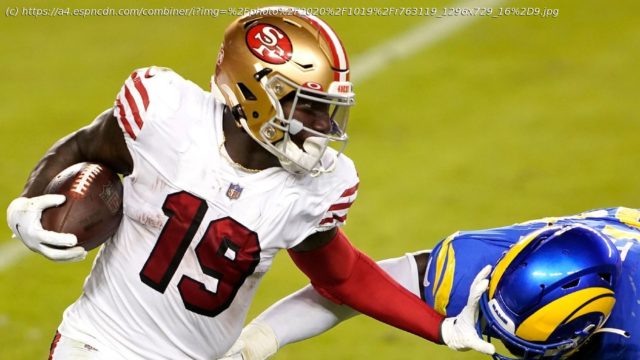Mike Clay breaks down each NFL team with a key fantasy football fact to get you ahead of the curve for Week 7 and beyond.
The Fantasy 32 analyzes the NFL from a fantasy perspective, with at least one mention of each of the league’s 32 teams. Though efficiency will be discussed plenty, the column will lean heavily on usage data, as volume is king (by far) in fantasy football. Use these tidbits to make the best waiver-wire, trade and lineup decisions for the upcoming week and beyond. Be sure to check back each week of the season for a new version of the Fantasy 32. Note that data from Monday Night Football might not immediately be reflected in charts. Throughout the below team-by-team rundowns, I’ll be referencing “OFP” and “OTD.” OFP stands for opportunity-adjusted fantasy points. Imagine a league in which players are created equal. OFP is a statistic that weighs every pass/carry/target and converts the data into one number that indicates a player’s opportunity to score fantasy points, or his “expected” fantasy point total. For example, if a player has an OFP of 14.5, it means that a league-average player who saw the same workload in the same location on the field would have scored 14.5 fantasy points. FORP is the difference between a player’s actual fantasy point total and his OFP. OTD works the same way, except instead of fantasy points, it’s touchdowns. Volume is king in fantasy football, so this is not information you want to overlook. That said, here is the post-Week 6 OFP Leaderboard: *Complete OTD and OFP positional leaderboards will be posted on ESPN+ this week. Next, here are the players who exceeded their OFP by the largest margin this past week and are thus candidates to see a dip in fantasy production moving forward, assuming they see a similar workload: And these players fell short of their OFP by the largest margin last week, and thus you shouldn’t be too quick to overreact to their performance when making lineup, trade or waiver decisions: Arizona Cardinals: Has the Kenyan Drake we knew and loved last season — and then again during 2020 draft season — finally returned? It’s possible after Arizona’s lead back went for 164 yards and a pair of touchdowns on 20 carries against Dallas’ imploding defense on Monday Night Football. Drake played on a healthy 70% of the Cardinals’ offensive snaps, which is a good sign. However, he was once again a nonfactor as a receiver with zero catches on two targets. Drake is up to No.19 in RB fantasy points, but Monday marked his first weekly finish better than 17th. Barring a significant boost in targets, he’s likely to continue producing borderline RB2 numbers — but no better. Atlanta Falcons: I think it’s safe to say Julio Jones is back. The 31-year-old superstar missed all but 15 snaps during Atlanta’s previous three games but exploded back onto the fantasy scene with an 8-137-2 receiving line on 10 targets against Minnesota on Sunday. Jones has now played three full games this season, and two resulted in 10-plus targets and 25-plus fantasy points. Jones, who led Atlanta’s wide receivers with 64 snaps on Sunday, is a top-30 fantasy receiver despite all the missed action. He, of course, remains a solid WR1 and has a great matchup against Detroit in Week 7. Baltimore Ravens: Mark Ingram II left Sunday’s game against the Eagles with an ankle injury after nine snaps. In his place, Gus Edwards played 30 snaps (45%) and rookie J.K. Dobbins played 27. Edwards also paced the unit with 14 carries but was held to only 26 yards, compared to nine carries for 28 yards for Dobbins. Edwards wasn’t targeted, and Dobbins was held to 1 yard on four targets. If Ingram misses time (which is far from a lock with Baltimore headed to its bye), we can count on, at least, a two-headed attack with Edwards and Dobbins, though Justice Hill could also see a few passing-down snaps. Considering Baltimore’s running backs rank 22nd in fantasy points and 29th in targets this season, this isn’t a particularly enticing situation, but Dobbins would be the best flex option in that scenario. Buffalo Bills: Zack Moss finally returned from injury on Monday night, but the rookie was all but a nonfactor against the Chiefs. Moss played on just 13 of 50 (26%) of Buffalo’s offensive snaps, which was well behind the 37 snaps played by Devin Singletary. Singletary didn’t do much either, with 10 carries for 32 yards and 13 more yards on a pair of targets. Moss accrued a mere 10 yards on five carries and wasn’t targeted at all. Singletary flashed a bit earlier in the season, but has struggled to reach 78 yards on 23 touches (with no TDs) during Buffalo’s last three games. Moss, who had played on a generous 44% of the Bills’ snaps during the first two weeks of the season, only figures to see more work as the season progresses. He remains worthy of a bench spot in 12-team leagues. Carolina Panthers: Teddy Bridgewater ran the ball eight times for 48 yards on Sunday, both of which are new career-high marks. The rushing production helped offset a rough passing day (216 yards,0 TDs,2 INTs) to some extent, though Bridgewater finished 15th or worse at the position in fantasy points for the fourth time in six games. Bridgewater has thus far been about as matchup dependent as they come, posting duds against good Buccaneers, Chargers and Bears defenses, but proving serviceable against the Raiders, Cardinals and Falcons. He has only one weekly finish better than 12th to his name, so there’s obviously not much upside here, but perhaps that can change if he keeps running the ball as often as he did Sunday. For now, Bridgewater is best viewed as a mid-range QB2 and occasional streaming option. Chicago Bears: Remember Anthony Miller? Yeah, me neither. A popular breakout candidate in both his second (2019) and third (2020) NFL seasons, Miller has plummeted off the fantasy radar. The 2018 second-round pick is averaging 4.3 targets per game, and that includes a Week 6 performance in which he caught all three of his targets for 8 yards. Miller found the end zone in Weeks 1 and 3, but he hasn’t cleared 41 yards in a game since Week 1 and has posted two weekly finishes better than 60th. Miller, who has played 53% of the offensive snaps this season, obviously does not need to be on rosters. Cincinnati Bengals: Is A.J. Green back? It sure seemed like it Sunday when the 32-year-old put up an 8-96-0 receiving line on 11 targets while playing a season-high 80% of the snaps against a good Colts defense. Green entered the week with a total of 119 yards on 14 catches in five games, but heavy volume (34 targets) suggested better days were ahead. There are several mouths to feed in the Bengals’ offense, especially after rookie Tee Higgins had another strong day Sunday, but Green’s usage in a Bengals offense that has attempted a league-high 246 passes is enough to keep him in the WR3/flex discussion. The Bengals’ wideouts are set up with a good Week 7 matchup against a Browns’ defense that has allowed the fourth-most fantasy points to wide receivers this season. Cleveland Browns: Austin Hooper caught five of six targets for 52 yards against the Steelers on Sunday. Hooper has either 50-plus receiving yards or a touchdown in three consecutive games, which has worked out to double-digit fantasy points each week. Hooper, who has at least six targets and exactly five catches during the span, is up to fifth at tight end in receptions for the season and sits fifth in fantasy points since Week 4. He’s a fringe TE1. Dallas Cowboys: Andy Dalton’s first start with Dallas did not go well. The longtime Bengals starter completed 34 of 54 passes for 266 yards, one touchdown and two interceptions. Those numbers would have been significantly worse if not for garbage-time production.






